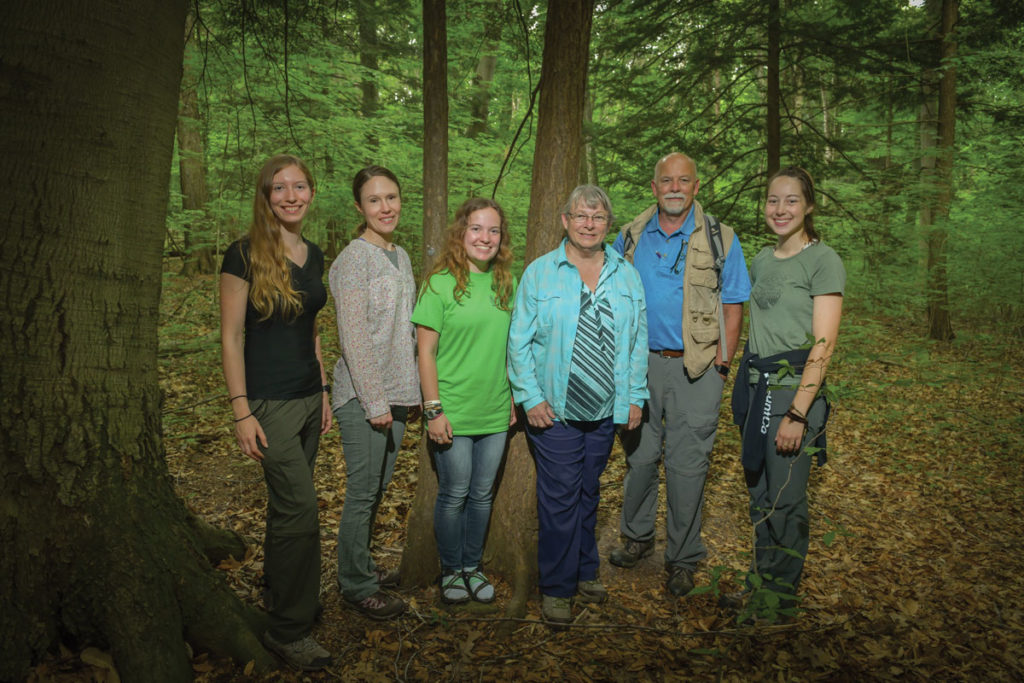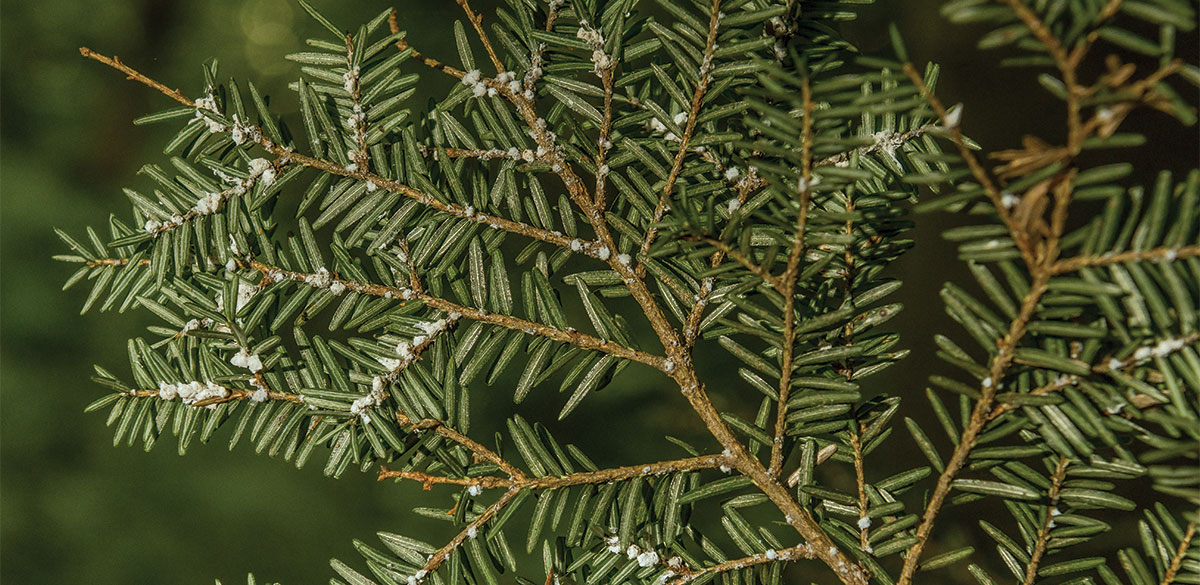Confronting a Threat in West Michigan Forests
Kathy Winnett-Murray, Ph.D. | Professor of Biology
K. Greg Murray, Ph.D. | T. Elliott Weier Professor of Plant Science
Vanessa Muilenburg, Ph.D. | Assistant Professor of Biology
It’s enough to make a grown man cry.
And Dr. K. Greg Murray admits he shed a tear upon discovering that the dreaded hemlock woolly adelgid had been spotted on hemlocks in Michigan. The invasive, destructive insect (pronounced a-DELL-jid), which sucks the sap from North American hemlock trees and dooms many of them, has taken hold in the 55-acre Hope College Nature Preserve.
“I knew they were going to get here sooner or later,” Murray laments. “It did not surprise me. But having seen forests in the Northeast and the effects they have … This patch of forest Hope College owns is really special to me because we’ve spent a lot of time there, over 32 years. So yes, it did bring a tear to my eyes.”

Dr. Kathy Winnett-Murray, Dr. K. Greg Murray and Analise Sala ’19
His “we” includes Dr. Kathy Winnett-Murray. The veteran husband-wife educators have teamed up with Dr. Vanessa Muilenburg, an entomologist, to assess the extent of the adelgid infestation and determine the importance of hemlock trees in West Michigan forests. They spent summer 2018 doing field work with three Hope students: Katelyn DeWitt ’21 and biology majors Analise Sala ’19 and Micaela Wells ’19.
The researchers spent many hours amid the hemlocks in Hope’s nature preserve about five miles southwest of the campus, near the Lake Michigan shoreline, and at three other sites in Allegan and Ottawa counties. Winnett-Murray says that because of Lake Michigan’s unique influence in creating moisture-rich and canyon-like dune troughs, West Michigan is one of the few places in the Great Lakes region where hemlocks thrive amid forests of beech and maple trees.
“I’ve been an ecologist for a long time, but I’m hoping to learn more about why it makes a difference how diverse a forest is,” she says. “When we lose some of the diversity, what are the consequences?”
Hemlock woolly adelgids are black and smaller than the head of a pin in their “crawler” stage. The pests attach themselves to the base of a hemlock’s needles and suck sap from the tree. Once they’ve laid their eggs — up to 300 at a clip — they cover themselves and the eggs with a white, woolly, sticky secretion.
Adelgids have infested hemlocks on both coasts of the United States for years. They can’t fly; scientists think interstate transit of nursery trees introduced the insects to Michigan. Their sticky egg masses also can adhere to passing birds or animals and be transported to a new location. Scrupulous attention when moving yard waste, firewood and the like helps rein in the insects’ spread, Muilenburg emphasizes. But there is no practical way to eradicate them from an infested forest.
Identifying the infested trees in the Hope nature preserve required binoculars and much patience. “Lots of infestations start at the top of trees. They’re easy to miss,” Muilenburg reports. The team estimated in mid-2018 that roughly 13 percent of the hemlocks in Hope’s preserve were infested, but the effects were not yet severe. They’ll monitor the area indefinitely, and students in the Department of Biology’s Advanced Topics in Ecology class may engage in that effort. Other scientists will continue to assess the infestation and its rate of spread at other locations.
“We expect the trees to start showing signs of stress over the next several years, as the infestations develop,” Dr. Murray says.
He speaks of stress rather than destruction because while the insects are the trees’ downfall, their sap-sucking behavior typically doesn’t strike the fatal blow. “Over time, when you get enough of them, a tree becomes weak. It can’t tolerate a drought, say, so it will die,” Muilenburg explains.
It’s impossible to estimate how long it might take for hemlock woolly adelgids to destroy much of the hemlock population in Hope’s nature preserve.
“This area doesn’t have a lot of evergreens,” Wells says. “It’s sad to know that probably in a few decades, we’re not going to have these hemlocks anymore.”
Sala adds, “I just really hope our work will help show what these trees contribute to the forest structure, so that when they do go, we can mitigate the impact of losing them.”
Winnett-Murray expects that impact to center in unique microenvironments that hemlocks create on the forest floor of the beech- and maple-dominated forests near Lake Michigan, which are different from forests a bit further inland.
“Because hemlocks are interspersed among the deciduous trees, those unique microenvironments are patchy,” she says. “One of the goals of our project is to understand how those patchy conditions on the forest floor affect other organisms, and thus the characteristics of these coastal forests in general.” Winnett-Murray and her colleagues want to learn more about how individual hemlocks influence the ability of other plants to establish near them — which is key, in the long run, to which species become established in a forest.
Keep up on efforts to battle the hemlock wooly adelgid in West Michigan.


One thought on “Confronting a Threat in West Michigan Forests”
Comments are closed.